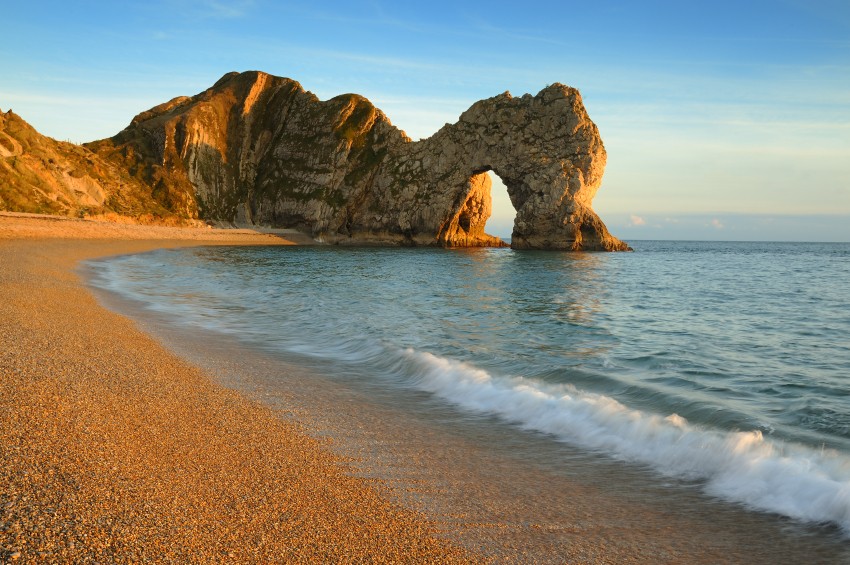Jurassic Coast Itinerary – How to spend a long weekend in Dorset
Visiting Dorset & The Jurassic Coast
This jurassic coast region of the UK is situated on the south coast of England and is home to a diverse, stunning coastline which stretches for 95 miles: the Jurassic Coast. It begins in Exmouth in Devon and finishes at Old Harry Rocks, near Swanage in Dorset.
The Jurassic Coast gets its name from the geology of the land that makes up this area. It dates back 145 million years ago to the Mesozoic Era, which is when the Triassic, Jurassic and Cretaceous periods were and you can see evidence of all of these types of rock along the coastline. If this all sounds a bit too scientific for you, the Jurassic Coast website has some useful easy-to-understand info!
There’s loads to see and do here, and I recommend booking as long as your calendar allows to explore this beautiful destination in England. We visited Dorset and the Jurassic Coast for a long weekend in late September with our two dogs, so we made sure the activities we chose were dog-friendly and enjoyable for everyone.
Here’s how to see this part of England in a long weekend.
Jurassic Coast Itinerary: Getting to Dorset and Getting Around
Dorset is a 2 hour drive from London. There are good transport links to this area of the country, but if you want to maximise time in Dorset it’s recommendable to travel by car; transport links between the major sites aren’t as easy to come by.
By Bus: The National Express Coach takes 3h45m from London to Weymouth and only costs £10-15 each way if you book in advance. You can purchase tickets through the National Express website.
By Train: The train from London to Weymouth takes just over 3 hours and costs upwards of £50 one way but you can get cheaper tickets with a railcard. Search for train fares here.
By Plane: The best airports to this area of England are London Gatwick, London Heathrow, Southampton or Bristol, depending on where you’re flying from. Search for flights with Skyscanner here.
By Car: Getting around Dorset and the Jurassic Coast is easiest by car. I use AutoEurope to compare rental cars when I travel.
Jurassic Coast Itinerary: Where to stay in Dorset
I recommend staying in Weymouth or Dorchester for the duration of your long weekend in Dorset; then you’ll be slap bang in the middle of the sights to see on the Jurassic Coast. Browse Booking.com to find accommodation in the area or try AirBnB use this link for £30 off your first AirBnB booking.
We stayed at a lovely little AirBnB in a village called Mosterton. This was a good location and we liked being in the countryside away from the crowds. With lots of great dog walking opportunities on our doorstop. However we were much further West than East. Which meant we had a bit of a drive when visiting Old Harry Rocks.
Day 1: Lyme Regis & West Bay
Spend your first day in Dorset exploring the West of the region.
Lyme Regis
Lyme Regis is a popular seaside town, which is quaint and pretty and very British! The houses are painted in different pastel colours, much like the beach huts along the sand. Spend the morning wandering around along the seafront.
Things to do in Lyme Regis:
- Wander along the Marine Parade to the Cobb – the marina where the boats are stationed.
- Go kayaking, paddle-boarding or on a RIB ride
- Visit the Lyme Regis Museum or Dinosaurland Fossil Museum
- Take a guided walk to find fossils on Fossil Beach
Relax or walk along the beaches: Town Beach is the sandy beach by Lyme Regis town, Monmouth Beach is to the west of the Cobb. Charmouth Beach is a short drive away or you can hike there – the walk is about 4 miles long.
West Bay
In the afternoon, drive to West Bay (it’s about a 30 min drive from Lyme Regis). This is a sleepy coastal town which is appealing for its necessity to relax, alongside its stunning scenery. The towering cliffs that stand on East Beach are an incredible sight, and were used as a filming location in !
Things to do in West Bay
- Grab a bite to eat from one of the many food stalls or at Rise cafe
- Wander the seafront and marina
- Hike along the coastline to the nearby village of Eype in the West (via the Jurassic Pier) or Burton Bradstock in the East (up East Cliff)
- Head to nearby Bridport and visit Bridport Museum
- If you’re partial to a tipple, visit Palmers Brewery or the Furleigh Wine Estate
Day 2: Exploring the Iconic Landmarks of the Jurassic Coast
Your second day should be reserved for exploring some of the most iconic sites that make the Jurassic Coast world-famous. Head towards Durdle Door, a natural limestone arch that has become one of the most photographed landmarks in England. Don’t forget to visit Lulworth Cove, a beautiful circular bay formed by the power of the sea. Both locations are part of the UNESCO World Heritage Site and showcase millions of years of geological history.
After that, drive towards Old Harry Rocks, located near Swanage. These striking chalk formations stand tall above the sea and mark the eastern end of the Jurassic Coast. The views here are stunning, especially at sunset, making it a must-visit spot for photographers and nature lovers. And if you’re planning a longer trip, consider staying at the New England Boston Hotel, which offers stylish comfort and warm hospitality perfect for relaxing after a day of coastal exploration.
Day 3: Relaxation, Coastal Walks & Hidden Gems
Spend your final day exploring the quieter parts of the coast. Studland Bay offers golden sandy beaches and is ideal for swimming or relaxing after days of sightseeing. Take a walk along the South West Coast Path, one of the UK’s most scenic trails, stretching across the entire Jurassic Coast.
If you prefer something unique, visit Charmouth Beach, known as one of the best fossil-hunting spots in the world. You might even find ammonites or small marine fossils embedded in the rocks. End your trip with a meal at a local seaside pub to enjoy traditional Dorset dishes like fish and chips or locally sourced crab.
Conclusion
The Jurassic Coast is a treasure trove of natural wonders, history, and breathtaking beauty. Whether you’re chasing fossils, hiking dramatic cliffs, or simply relaxing on the beaches, this stretch of coastline offers something unforgettable for everyone. Plan your visit with the help of The Tourists World your trusted travel companion for detailed itineraries, travel inspiration, and destination guides from around the globe.
FAQs About the Jurassic Coast
1. Why is the Jurassic Coast famous?
The Jurassic Coast is famous for its unique geological formations and fossil-rich cliffs that reveal 185 million years of Earth’s history. It’s also a UNESCO World Heritage Site.
2. What are the best places to visit along the Jurassic Coast?
Top attractions include Durdle Door, Lulworth Cove, Old Harry Rocks, Lyme Regis, and West Bay. Each spot offers breathtaking views and natural beauty.
3. Can you find fossils on the Jurassic Coast?
Yes! Charmouth Beach and Lyme Regis are popular fossil-hunting locations. Guided fossil walks are also available for beginners.
4. What is the best time to visit the Jurassic Coast?
The best time to visit is between May and September, when the weather is warm and perfect for coastal walks and beach activities.
5. How long should I spend exploring the Jurassic Coast?
A long weekend (3–4 days) is ideal to see the highlights, but spending a full week allows you to explore both the popular and hidden gems at a relaxed pace.






